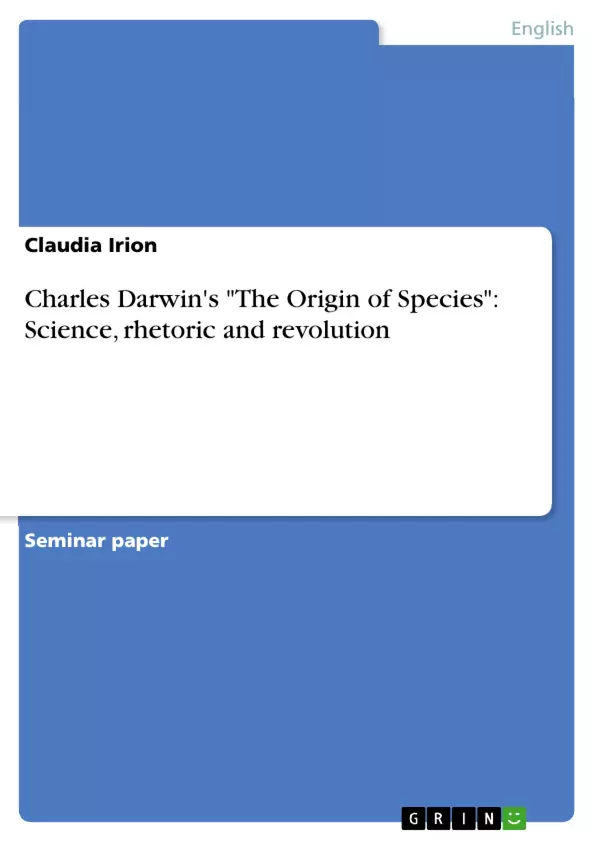"Only now can we appreciate in how many different ways the Origin departed from established concepts and how many new directions it opened up. Every modern discussion of man’s future, the population explosion, the struggle for existence, the purpose of man and the universe, and man’s place in nature rests on Darwin."
With these words Ernst Mayr opens his introduction to the facsimile of the first edition of Darwin’s The Origin of Species and thus outlines the dimensions of its significance and place in cultural history. The difference, which separates the book and its author from many other scientific works of similar importance, is the degree to which it has been brought up in public debates. Additionally, it was noticed that Darwin’s success had also something to do with his talent as a writer: he made us see the world in a different light with figures of speech. But to claim that Darwin was a rhetorician is not to dismiss his science, but to draw attention to his accommodation of his message to the professional and lay audiences whose support was necessary for its acceptance. While the debate in natural sciences was largely over by the end of the 1940s, the cultural debate came up again. Catchwords like Social or Cultural Darwinism indicate the transfer of the biological theory to other spheres. Nowadays, most of the main religions have accepted the theory of evolution and promote a co-existence of scientific description and religious traditions.
In the course of this essay, I will first attempt to shed light on the historical background, beginning with a short survey of evolutionary thought up to the publication of the Origin (I.1). In addition, I will have a closer look at Darwin and his work itself (I.2). In chapter two, Darwin is presented as a rhetorician and attention is drawn to the most amazing rhetorical figures he uses in his work (II.1). My aim is not to provide a comprehensive study, a task that is beyond the scope of this essay, and therefore certain aspects can not be dealt with and others will only be touched upon. In the end, the last part of this essay will be an attempt to introduce the reader to the reception of Darwin’s theory (II.2). Certainly, this can only be a broad overview, focusing on major subjects as religion, science and the way in which Darwin’s work was used to justify political and social concepts (II.2.2).
Inhaltsverzeichnis (Table of Contents)
- Introduction
- I Historical Background
- I.1 Survey of evolutionary thought up to 1859
- I.1.1 Biblical Creationism
- I.1.2 The first transmutationists: Erasmus Darwin and Jean-Baptiste Lamarck
- I.2 The development of Darwin's theory
- I.2.2 The arguments of the theory
- I.2.2 Darwin's style and scientific method
- I.1 Survey of evolutionary thought up to 1859
- II Darwin's On the origin of Species: A rhetorical text
- II.1 Rhetorical figures
- II.1.1 Simile and metaphor
- II.1.2 Personifications
- II.2 After the publication
- II.2.1 The reception of Darwin's theory
- II.2.2 Social uses and abuses of Darwinian thought
- II.1 Rhetorical figures
- Conclusion
Zielsetzung und Themenschwerpunkte (Objectives and Key Themes)
This paper explores the historical and rhetorical aspects of Charles Darwin's "On the Origin of Species," examining its impact on scientific and cultural discourse. The work analyzes Darwin's approach to scientific methodology and his use of rhetorical figures to present his revolutionary theory.
- Evolutionary thought before Darwin
- Darwin's scientific method and argumentation
- Rhetorical elements in Darwin's writing
- Reception of Darwin's theory in science and society
- Social and political uses and abuses of Darwinian thought
Zusammenfassung der Kapitel (Chapter Summaries)
The first chapter provides a historical context by surveying evolutionary thought before Darwin's publication. It explores ideas of Biblical creationism, early transmutationists like Erasmus Darwin and Jean-Baptiste Lamarck, and the scientific discoveries that contributed to the debate surrounding the origin of species. The chapter explores the intellectual climate and cultural context in which Darwin's work emerged.
The second chapter delves into Darwin's work itself, examining his style and scientific method. The focus shifts to Darwin's rhetorical techniques, analyzing the use of similes, metaphors, and personifications in his writing.
Schlüsselwörter (Keywords)
The primary keywords and focus topics of the paper include evolutionary theory, scientific method, rhetoric, Darwin's "On the Origin of Species," Biblical creationism, Lamarckism, social Darwinism, cultural Darwinism, and the reception of evolutionary thought in science and society.
- Citar trabajo
- Claudia Irion (Autor), 2008, Charles Darwin's "The Origin of Species": Science, rhetoric and revolution, Múnich, GRIN Verlag, https://www.grin.com/document/92430



